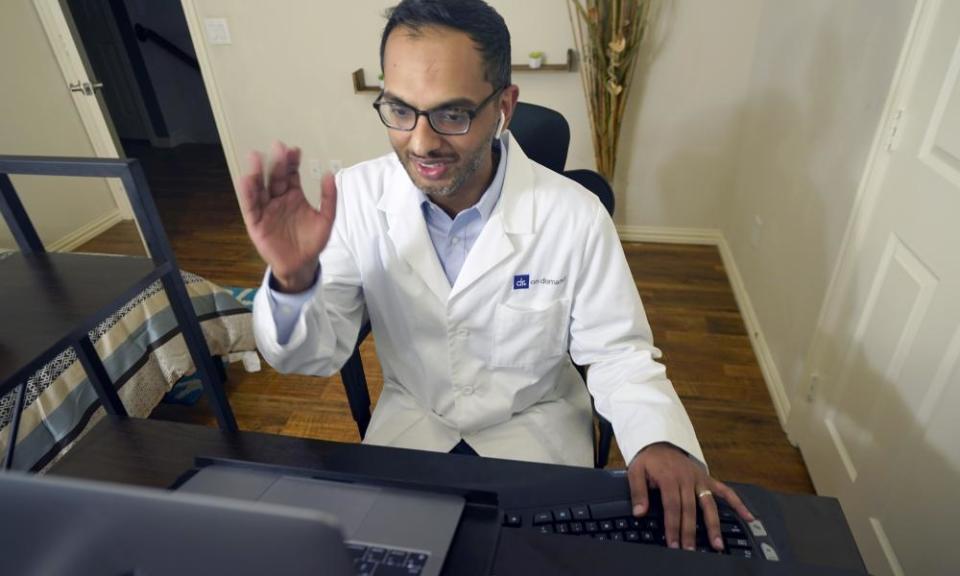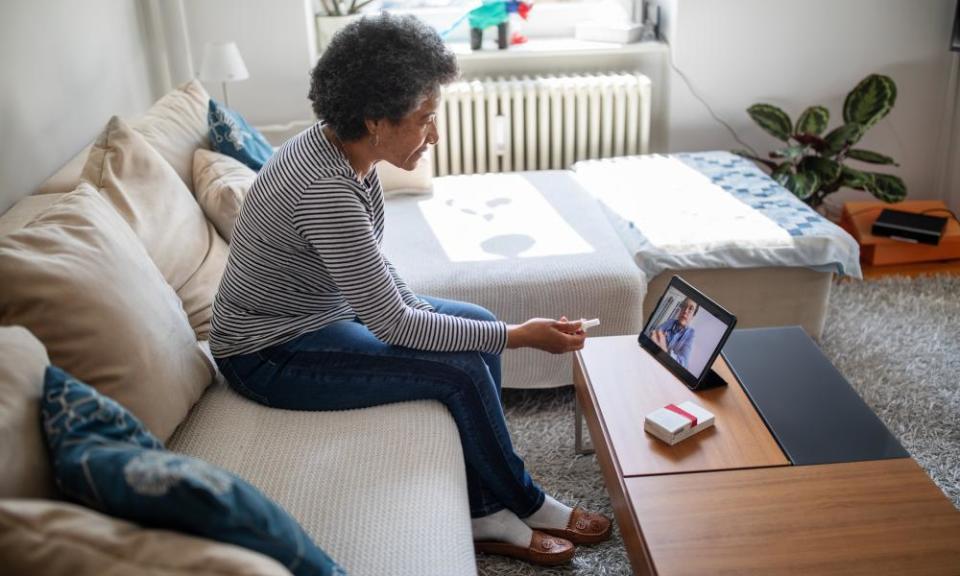Telemedicine companies seeking to cash in on Covid pandemic boom

Companies are hoping to cash in on what has become one of the inarguable winners in the pandemic economy – virtual healthcare – by offering subscriptions to circumvent the complex US health insurance system.
Think Netflix, but for medicine. At least, that’s the promise to patients.
“For telemedicine, it definitely exploded,” said Gloria Lau, the co-founder and CEO of Alpha Medical, a Silicon Valley-based virtual care startup. “Covid is the key driver, and it’s not just on the patient side, it’s the provider side.”
Related: Why 'Zoom medicine' is not the answer to all our ills | Josh Hall
Starting last year, doctors and patients sought to avoid face-to-face encounters, moving appointments for everything from head colds to anxiety to hormone replacement therapy online. As the virus surged from 2020 February to April, insurance claims for telehealth visits grew from about 529,000 to peak at more than 12m a month. The demand for telehealth visits has since sunk to 8.8m claims a month, still light-years ahead of where it was in 2019.
Potential exposure to Covid-19 superseded every other consideration in consumer surveys. Widespread telehealth also eliminated some of the most annoying, or downright impossible to overcome, aspects of going to the doctor. People no longer needed to take time off work, find childcare, drive a long distance and park a car.
The promise that so much healthcare could be delivered virtually, conveniently – and appealing in the US – cheaply, has perhaps never seemed more feasible. A subscription to Alpha Medical costs just $120 a year and promises “unlimited messaging” with a provider, though no in-person treatment or prescriptions are covered.
But the latest iteration of “telehealth” promoted for everything from therapy to birth control, including by Alpha, will not look like telehealth as most patients understand it.
Right now, most telehealth visits are a live conversation with a doctor, usually your own, either on the phone or on video chat. Now, proponents of a new business model want patients and doctors to adopt “asynchronous” or “store-and-forward” care – you answer a series of questions in a detailed intake form, a doctor you may never meet reviews them – they may or may not message you – and then issues a diagnosis and treatment plan.
“We love the bright shiny new object, and virtual care is now the bright shiny new object,” said Dr David Blumenthal, a healthcare policy expert and president of the Commonwealth Fund, which advocates for accessible, affordable and universal healthcare.
Its supporters crow that asynchronous care will allow faraway doctors to reach faraway patients in far less time.
“The economics are clear: 3-6 visits in the same time it takes to do one video or in-person visit,” Oliver Lignell, vice-president of virtual health at Avia, wrote in a column in the industry publication MedCity News. Lignell proposed doctors could complete an asynchronous visit in three minutes or less.
These claims are not without merit. Disability activists, for example, have advocated for more virtual care for years.
“These stories are not only one-sided,” said Hannah Zeavin, a lecturer at the University of California Berkeley, and author of The Distance Cure: A History of Teletherapy.
In some sense, asynchronous care has been an important part of medicine for more than a century, evidenced by the care a Parisian doctor provided by post, or Sigmund Freud’s therapeutic letters to patients, Zeavin said. As recently as 2011, specialists at the Alaska Native Medical Center used asynchronous care to treat ear, nose and throat conditions in remote parts of the state, while also noting the critical importance of in-person exams.
The idea of a subscription to a doctor’s office is not especially novel in the US. Called “direct primary care”, in the past it has offered “concierge” services targeted to the wealthy and sometimes offered as a job perk.
Google and SpaceX offer a subscription to One Medical, a tech-heavy direct primary company which promises online “care whenever you need it”. But the telehealth aspect of the company is still connected to brick-and-mortar clinics conveniently located in high-end neighborhoods theoretically near the office workers and individuals to whom they cater. One Medical raised $245m in an initial public offering in 2020 January.
Alpha targets an entirely different demographic, pitching itself as a “health care solution” to “gig and part-time workers”, freelancers and the long-term uninsured. These are the people Blumenthal describes as “disenfranchised” from the American health system.
The phenomenon is, “symptomatic, to use medical terminology, of a deeper disease”, said Blumenthal. “And that disease is a systematic lack of insurance for about 30 million Americans.”
Lau describes Alpha’s existing “patient demographic” as “mid- to low-income”, in high-deductible insurance plans which require patients to spend thousands of dollars up front before insurance kicks in, or in some cases people who are uninsured long-term. In these cases, subscriptions are less expensive than traditional insurance.

“Obviously, we have lots of patients who don’t have insurance, they don’t have any insurance at all,” said Lau. “Some of them are in and out of jobs … Other times, you have people who choose to be independent or self-employed. Oftentimes, they may or may not have insurance for a long period of time.”
The importance of this new asynchronous model was growing even before Covid-19. In 2019 October, California’s Governor Gavin Newsom signed a law to increase the amount the state would pay for patients who receive asynchronous care through its public health insurance program for the poor and disabled, Medicaid.
But as the field has grown, some companies have focused exclusively on the virtual aspect of care. Alpha is one small player, having raised just $11m according to CrunchBase. It may refer people for in-person visits but never pays for them.
To date, the largest companies in the field focus on mental health, such as TalkSpace. The company plans to go public this year in a $1.4bn deal.
However, companies like Alpha promise to treat physical ailments, in a business model Lau envisions will one day be the first point of care for patients to be “triaged” before speaking to a real doctor. “We’re lowering the cost of care a lot,” Lau said. “Hopefully, over time, it will reduce the cost to provide insurance to employees.”
But Zeavin said the drive for lower costs holds the potential for a more unsettling direction for medicine.
“This is the dystopian nightmare,” said Zeavin, that “this is the first form anyone gets before they can do anything. That would massively shift what kinds of care are possible for the people who most need these additional forms of access and care precisely, because of the ableism in healthcare, red-lining and homophobia.”
Others are less certain such a direction is imminent.
“If you’re going to be triaged, who’s going to make money on that?” said Dr Jay Parkinson, co-founder of Sherpaa, an asynchronous virtual primary care company that was purchased by Crossover Health, another virtual care company. Typically, Sherpaa was provided as a benefit to white-collar workers with private healthcare at companies such as Four Square, Casper and Tumblr.
“The traditional healthcare system makes a lot more money from being inappropriately utilized,” said Parkinson.
There are also labor implications involved in triaging patients at this speed. “Asynchronous care can be really bad for the humans providing the care,” said Zeavin. TalkSpace has revised provider payment models in the past, and Alpha declined to say how much it pays doctors.
Whether the business model can actually solve America’s broken healthcare system remains to be seen. One of Alpha’s chief claims was that, “over 70% of medical conditions including cold and flu, rashes, and more” can be treated online. It is a comment Lau echoes in conversation.
“The majority of things can be treated via telemedicine now,” she said. “The other 20-30% that needs to be in person, should be in person.” But this claim proves hard to back up.
To explain how it found this figure, a company spokesperson first directed the Guardian to a statement widely published in articles about telemedicine, attributed to the American Medical Association (AMA).
“Almost 75% of all doctor, urgent care, and ER visits ‘are either unnecessary or could be handled safely and effectively over the phone or video,’ according to statistics from the American Medical Association and the Wellness Council of America,” the statement said.
The AMA denied ever saying this.
“I can confirm that the AMA is NOT the source of the statement or statistic,” said Robert Mills, a media coordinator for the AMA who handles telemedicine inquiries. “The AMA is unaware of the original source, but the statement has been parroted by many without double-checking with the AMA.”
Unable to back up the stat, a press representative for Alpha said the company would remove the claim from its website.
The fact that direct primary care services are not insurance is part of its appeal to both consumers and lawmakers. Insurance in the US is so expensive, often hundreds of dollars a month then thousands more when patients go to use it, that some people forgo it, hoping they will not be the victim of catastrophic medical debt from an accident or Covid-19, meningitis, cancer or another serious disease.
Companies that offer direct primary care subscriptions have quietly lobbied lawmakers to exempt thems from the oversight of state insurance commissioners. One such law was recently passed in Montana.
But, in an emerging industry, what has not been answered is what such an arrangement should cover.
“When you offer these alternative, very limited and in some cases deceptive plans, you give people who don’t want to buy insurance a feeling of security,” said Blumenthal. “It’s only dangerous if it encourages people not to get the insurance they actually need.”

 Yahoo Finance
Yahoo Finance 